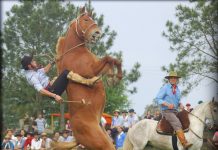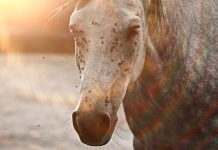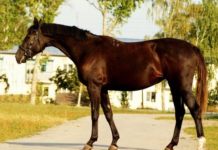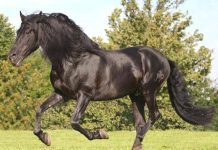The interesting Tarpan has a more “wild” appearance than a wild temperament. Basically, he’s a good-natured pony.
Now and then he shows his harsh side and wants to get his way.
Breed description

The Tarpan horse breed originally referred to a wild horse that was widespread from the Iberian Peninsula to the Russian steppes.
The last representative of this breed died in the 19th century. Today the Tarpan is once again a recognized breed.
It is based on back-breeding based on the appearance of the original animals.
Size: 125-135 cm
Weight: 200 – 250 kg
Origin: Poland
Lifespan: 25-30 years
Color: Fallows with eel line
Suitable as: Leisure time, draft horse
Origin and breed history
The Tarpan is a very old breed of horse. Its original wild form, together with the Przewalski horse, is one of the original forms of today’s domestic horses.
The range of the Tarpan extended over all of Europe. Intensive hunting caused it to shrink to an area from Central Europe to the Urals in the 16th century.
There were two types of tarpan: The stronger forest tarpan lived in Central and Eastern Europe. The steppen tarpan was native to the steppes of southern Russia. This was smaller and more delicate.
The Tarpan initially lived wild in large herds of up to 100 animals. Some 6,000 years ago the domestication of some horses began. Until the 18th century, free herds lived in the south of Ukraine, the lower Djneper, and the Crimea.
The domesticated animals were used as workhorses. The tarpan was a pack horse and a driving horse. The meat of the animals served as food, especially in the harsh winters, but it was also considered a delicacy among the nobility.
The intensive hunt ultimately contributed to the animals becoming extinct. Another reason was crossbreeding with domestic horses, which reduced the pure-blood population.
In the 18th century, the Russian prince Zamojski recognized the slow extinction of the Tarpan and tried to preserve the purebred. He owned one of the last purebred herds of wild horses.
An unexpectedly harsh winter reduced his funds for the entertainment of the animals so much that he had to give them to farmers. The farmers could not use the small animals for fieldwork and crossed them with other horses.
This is how the Koniks came about. The tarpan became extinct at the end of the 19th century. In the 1930s, Heinz Heck began back-breeding the Tarpan in the Hellabrunn Zoo in Munich. Back breeding also took place in Poland.
It is a matter of so-called image breeding. There is no clear evidence of what the Tarpan really looked like. The cultivars are an approximation of a certain image of the original tarpan. Breeding is limited to various traits that the Tarpan probably had.
Two descriptions by naturalists mainly serve as sources for the back-breeding. The German Samuel Gottlieb Gmelin and the Russian Peter Simon Pallas observed wild herds in the 18th century.
It is controversial whether the original shape had a standing mane. Today’s Tarpan originated from crosses of Koniks, Huzuls or Dülmen horses, Przewalski horses, Icelandic, Scandinavian and Polish ponies.
You can watch Tarpan wild herds again today. In Germany, for example, in the Haselünne or in the Popielno forest in Poland. The Tarpan is considered a slightly endangered breed.
The appearance of the tarpan
Individuals of today’s breed are between 125 and 135 cm tall and weigh 250 kg. The gray fur with an eel line, i.e. a dark line on its back, is typical of the Tarpan.
There are variants in different yellowish and brownish tones. Everything is dun, that is, the horse’s body is always light, the hair and badges are always dark.
The Tarpan often wears a shoulder cross as a badge as well as horizontal stripes on the darker legs (zebra stripes). The large nostrils are dark. The long hair of the mane, forelock and tail is thick and rough.
The mane of some animals is two-colored. The fur is longer than that of domestic horse breeds and very dense. The color lightening is typical in winter. You can immediately see the relationship to the wild horse in the Tarpan.
It looks compact and primitive. The coat is not as shiny and smooth as that of domestic horses. It looks rougher. The medium-sized, beautiful head is heavy and is determined by the strong ganashes (the cheeks).
The Ramsnase is striking, i.e. a round nose with a concave profile, which the horses usually show. They can also have a straight head or a ram head. The bridge of the nose and forehead of the animals are strikingly wide. The ears are small.
The neck is short and strong, it sits moderately high on the well sloping shoulders. Sometimes the lower neck muscles are very pronounced, sometimes the top line of the neck shows a nice curve. The neck ends in a flat withers.
The tarpan has a short, straight back with a short, round and slightly sloping croup. The tail is set low. The chest and ribs are moderately wide in the well-closed trunk.
The foundation of the Tarpan is stable, dry and delicate. You can easily see muscles, tendons and bones on the short, sometimes sturdy legs.
The tarpans now and then wear a light curtain on the fetters. The tarpan’s medium-sized hooves are round and very hard.
Temperament and essence
A tarpan has its own character. Every horse in this breed is different. Basically, however, the horses are smart, good-natured animals. Their ancestors were shy horses, yet brave.
It is said that Tarpan stallions kidnapped domesticated mares, attacked domesticated stallions, and sometimes killed them. The horses of today also show this ambivalence in character.
You can be open, curious, and approachable, but also headstrong and stubborn. Then they don’t put up with much. A tarpan is frugal, persistent and robust.
If you raise your Tarpan well, it shows great willingness to work, is reliable and has strong nerves. The latter in particular is a feature of the tarpans. They radiate an almost palpable calm. A tarpan is not prone to biting or wedging.
Their shrewdness enables them to learn new lessons quickly. Then they are suitable as good driving horses and riding horses for children. However, you should not leave the children unattended.
If you are small, it is possible that you can ride a tarpan. But then you have to train him for a long time. Because most tarpans are not used to lead ropes or even saddles.
Husbandry and nutrition
Attitude
The descent from wild and semi-wild horses predestines the Tarpan for keeping outdoors. Its fur is dense and protects it from moisture and cold.
Tarpans can spend the whole year in the paddock. The tarpan feeds on grasses, herbs, buds, shoots, and selected shrubs.
Nutrition
The food contains a lot of silica. If your tarpan is in a nutrient-rich meadow, it will get everything it needs.
If you have rather poor meadows on your doorstep, it can make sense to give mineral feed from time to time.
Your horse also receives important minerals and trace elements via a salt lick stone. A tarpan is a treat for a carrot.
However, you should be careful with treats of any shape to avoid colic. In winter you can feed the Tarpan with hay and concentrated feed.
Education and care

Upbringing
Raising a tarpan depends heavily on where you intend to use it. If you just want to enjoy the sight of the animals and use them for grazing, you don’t have to teach them much.
If you want to use them for riding or driving, you should work with them continuously. Depending on the character of the horse, you have to assert yourself more or less strongly.
You should be consistent in your upbringing and treat your tarpan well. Then the headstrong horse will cooperate. As a rule, a tarpan learns quickly, enjoys working and achieves a lot.
The horses are powerful in front of the wagon. Some tarpans were even used as school and therapy horses as well as competition horses for dressage and jumping competitions.
This is not actually what they are intended for. The limits of this breed in relation to its field of application have not yet been tested.
The ability of the horse depends heavily on the relationship with the rider and the upbringing. Well behaved horses can also be suitable for beginners. These are not raw horses, i.e. horses without training.
Maintenance
If you want to hold several tarpans, clean each other. If you only want to hold a tarpan, you have to take care of it, especially if you want to use the tarpan as a riding or driving horse.
The animals sweat more as a result of the movement. The saddle, bridle and harness leave bruises in the fur. You should brush these areas properly to avoid inflammation.
Cutting out the hooves is just as important. Even if your Tarpan is only standing in the meadow, you should check every now and then whether the hooves are healthy. Basically, the hooves renew themselves.
However, this process does not always go without problems. Such animals then paralyze in the wild and can no longer flee in an emergency.
To keep your tarpan healthy, you should hire an experienced farrier. This assesses the condition of the hooves and can cut them appropriately.
Basically, a tarpan doesn’t need much maintenance. It’s not that you never have to look after these animals.
Health and Typical Diseases
The tarpan is a resilient horse. There are no known breed-specific diseases. When the food supply is abundant, the horses tend to be overweight.
If you leave them out in the pasture in winter, the weight will regulate itself.
The Tarpan does not tolerate constantly damp subsoil in the long term. When he stands in swampy meadows, his hooves soften. Bacteria then have an easy job. Diseases such as thrush can result.
Life expectancy
With good care and species-appropriate husbandry, a tarpan reaches an average age of between 20 and 30 years.
Buy Tarpan horse breed
In Europe, there are some breeders and clubs that breed the Tarpan breed. Sometimes zoos and animal parks also give away a tarpan. The breed is rare.
For adult animals with good training, you pay between $3,500 and $5,500. The price depends on age, health, level of training, and the availability of papers (equine passport).
Animals with ID are always more expensive than those without. A tarpan that has been broken into or used as a draft horse costs more than a horse that was previously only in the paddock.
Decision support

A tarpan is a rugged pony. There is a small part of a wild horse in it. You should be aware of this if you are considering buying a tarpan.
The horses are good-natured, but also strong-willed. Depending on what you intend to do with the Tarpan, you should have experience in handling ponies and horses.
If you are a beginner and buy a poorly trained tarpan, it will dance your nose around. You should definitely familiarize yourself with the breed and your chosen Tarpan before buying.
Not every character of tarpan suits every person. The chemistry must be right.
Then nothing stands in the way of a profound training and pleasure in dealing with this diverse breed.






























